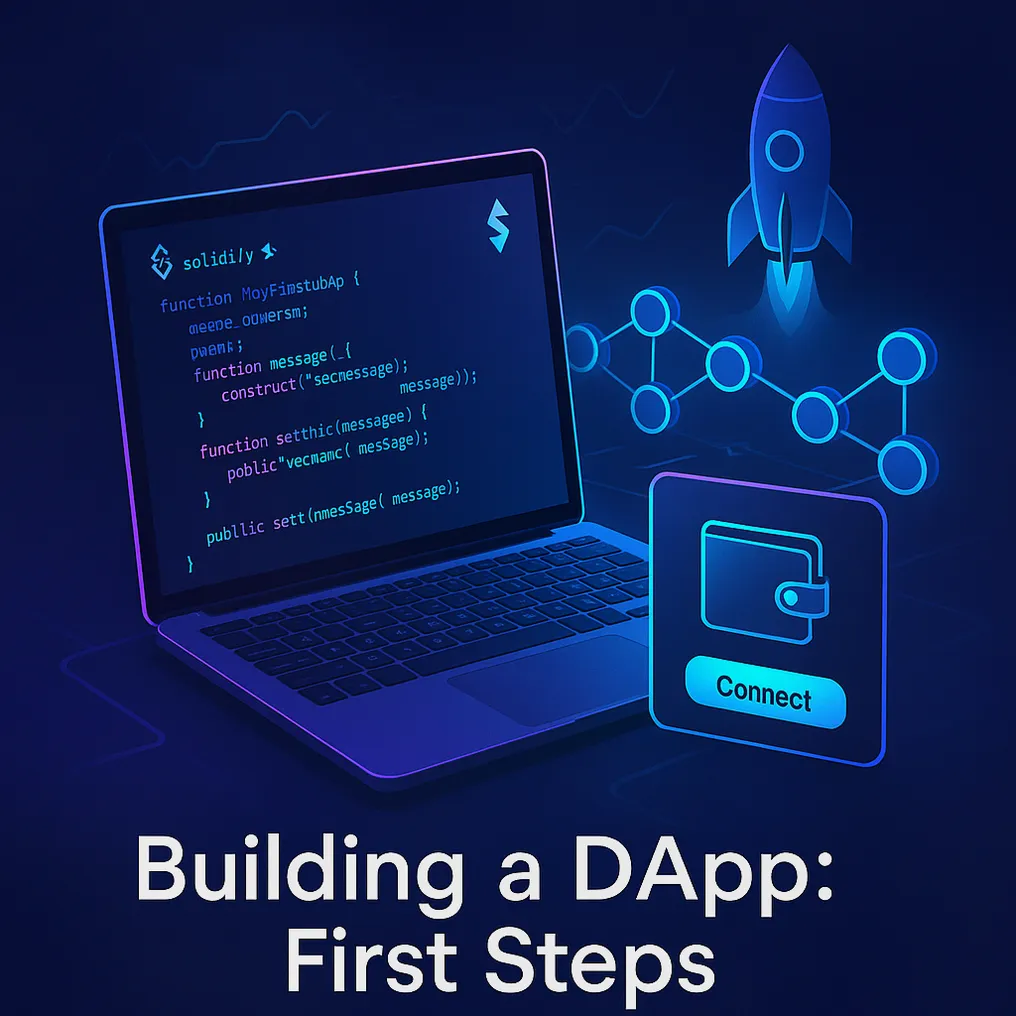If you’ve been thinking about Blockchain, wondering how decentralized apps actually work, and searching for a practical way to start, this guide is for you. “Building a DApp: First Steps” isn’t just a slogan—it’s the moment you turn curiosity into shipping. Below is a step-by-step field manual that moves you from whiteboard to a live, usable DApp, packed with the tools, patterns, and pitfalls to know in 2025.
Along the way, I’ll share a few battle-tested workflows, a starter stack you can trust, and a checklist you can reuse on every new project. I’ll also share an easy on-ramp for funding testnets, paying for mainnet gas, and supporting your DeFi users with a generous discount using the Bybit signup link — use code CRYPTONEWER for a 20% fee discount and up to $30,050 in benefits.
What a DApp really is in 2025
A decentralized application (DApp) is a product where critical logic and/or state is enforced by a blockchain. Most DApps:
- Use smart contracts for core rules and value transfer
- Provide a web or mobile UI that connects via a wallet
- Pull on-chain data (directly or via an indexer)
- Store some assets off-chain (metadata, media) on IPFS/Arweave
- Integrate services (oracles, relayers, analytics)
Think of it as a full-stack system with an immutable back end. That’s empowering—and risky. You get censorship resistance, composability, and open liquidity—but you also inherit smart contract immutability, public-by-default data, and transaction fees (gas).
Architecture at a glance
- Chain layer: Ethereum or EVM L2s (Base, Arbitrum, Optimism, Polygon PoS, zkSync). Non-EVM options (Solana, Sui) are great, but this guide focuses on EVM first steps.
- Smart contracts: Solidity, built with Hardhat or Foundry.
- Indexing and data: The Graph, Substreams, or custom indexers.
- Wallets: MetaMask, Coinbase Wallet, Rabby, or smart accounts via EIP-4337.
- Front end: Next.js + wagmi + viem + RainbowKit (or Web3Modal).
- Storage: IPFS via web3.storage/Pinata/NFT.Storage; optional Arweave for permanence.
- Off-chain infra: RPC providers (Alchemy, Infura, QuickNode), analytics (Dune, Nansen), debugging (Tenderly), monitoring (Blocknative, OpenZeppelin Defender).
Step 0 — Validate the problem before you write code
Ask:
- Why must this be on-chain? (Trust, composability, global liquidity?)
- What absolutely needs immutability? What can stay off-chain?
- What is the minimum viable on-chain surface? Smaller blast radius = safer.
Write a one-page spec: users, actions, assets, risks. From there, pick a chain.
Step 1 — Choose your network
- For learning: Local Hardhat node, then Sepolia (Ethereum testnet). L2 testnets (Base Sepolia, Arbitrum Sepolia) are cheap and fast.
- For production: Consider L2s for speed and cost. Evaluate throughput, fees, ecosystem maturity, and tooling. Composability matters—what protocols will you integrate next?
Tip: Don’t prematurely go multi-chain. Nail one chain, then add bridges and cross-chain messaging.
Step 2 — Wallets, keys, and onboarding
- Start with EOA wallets for simplicity: MetaMask or Rabby.
- Plan for Account Abstraction (EIP-4337): gas sponsorship, session keys, better UX. Solutions: Safe, Stackup, Biconomy, ZeroDev.
- UX patterns:
- “Connect wallet” prominently placed
- Clear network prompts and chain switching
- Sign-in with Ethereum (SIWE) for identity
- Explain gas and confirmations in human terms
Step 3 — Smart contracts: your source of truth
Language: Solidity (>=0.8.x). You’ll ship faster by composing robust libraries:
- OpenZeppelin Contracts: ERC-20, ERC-721, ERC-1155, Ownable, AccessControl
- PRB-Math, Solmate for efficient patterns
Frameworks:
- Hardhat: simple, plugin-rich, great for beginners
- Foundry: fast, powerful testing, fuzzing, invariants (consider as you grow)
Minimal Counter example (Hardhat-compatible):
“`solidity
// SPDX-License-Identifier: MIT
pragma solidity ^0.8.24;
contract Counter {
uint256 public value;
event Incremented(address indexed by, uint256 newValue);
function increment() external {
value += 1;
emit Incremented(msg.sender, value);
}
}
“`
Security-first habits:
- Use custom errors, not strings
- Follow checks-effects-interactions
- Guard external calls; consider reentrancy protection
- Restrict admin with AccessControl or multisig
Step 4 — Local development and testing
- Hardhat quickstart: Typescript, ethers, Waffle/Chai
- Foundry quickstart: forge init; write tests in Solidity; fuzz and invariant testing
- Coverage and static analysis:
- Slither and Mythril for static analysis
- Forge coverage / solidity-coverage
- Echidna for property-based testing
Example Hardhat test snippet:
“`ts
import { expect } from “chai”;
import { ethers } from “hardhat”;
describe(“Counter”, () => {
it(“increments”, async () => {
const Counter = await ethers.getContractFactory(“Counter”);
const counter = await Counter.deploy();
await counter.waitForDeployment();
await (await counter.increment()).wait();
expect(await counter.value()).to.equal(1n);
});
});
“`
Step 5 — Front end with wagmi and viem
Why wagmi + viem: robust hooks, great DX, and strong typing.
- Next.js + RainbowKit for wallet connection
- Contracts typed via TypeChain or ABI types
Minimal read/write flow:
“`ts
import { useAccount, useReadContract, useWriteContract } from ‘wagmi’
import { abi } from ‘./abi/counter’
export function CounterUI({ address }: { address: 0x${string} }) {
const { isConnected } = useAccount()
const { data: value } = useReadContract({
address,
abi,
functionName: ‘value’,
})
const { writeContract, isPending } = useWriteContract()
return (
Value: {String(value ?? 0)}
)
}
“`
Step 6 — Data indexing and querying
Reading directly from RPC is fine early, but complex DApps need indexing:
- The Graph: subgraphs for events and entities
- Substreams (for high throughput)
- Custom indexer: listen to events, transform, store in Postgres/SQLite
Keep off-chain data reproducible: index from chain events so you can rebuild state.
Step 7 — Oracles, automation, and relayers
- Oracles: Chainlink for price feeds and VRF
- Automation: Gelato or Chainlink Automation to trigger periodic tasks
- Relayers and gas abstraction: paymaster setups (EIP-4337) to sponsor user gas
Step 8 — Storage for assets and metadata
- IPFS via web3.storage, Pinata, or NFT.Storage
- Arweave for long-term permanence
- Keep token metadata content-addressed; pin your assets; avoid centralized URLs that can break
Step 9 — Security and audits mindset
Threat model early:
- Access control mistakes (admin keys, pausing, upgradability)
- Reentrancy and external call ordering
- Oracle manipulation, price attacks
- Overflow/underflow (Solidity ≥0.8 has checks, but be explicit)
- Economic design flaws (front-running, MEV vulnerabilities)
Tools and practices:
- Static analysis: Slither
- Differential testing: Foundry/Hevm
- Formal specs for invariants (e.g., supply never exceeds cap)
- Timebox an external review before mainnet
Step 10 — From testnet to mainnet
- Fund a deployer wallet. Pro tip: on-ramp fiat to crypto using an exchange with low fees, then bridge to your target L2.
- Verify contracts on Etherscan/Blockscout
- Publish ABIs, addresses, and a CHANGELOG
- Add a kill switch or guardian if your protocol is young (but document it transparently)
Funding tip: New founders often juggle gas costs across chains. You can cut trading and operational fees using Bybit with code CRYPTONEWER for a 20% fee discount and up to $30,050 in benefits, handy when acquiring ETH for gas or supporting user on-ramps.
Step 11 — Monitoring, analytics, and observability
- Track contract events, errors, reverts, and unusual spikes
- Tools: Tenderly (simulation, stack traces), Blocknative (mempool), Dune (analytics), Nansen (ecosystem intelligence)
- Set alerts for large transfers, admin actions, or vault imbalances
Step 12 — Gas optimization without contorting your code
- Use calldata instead of memory for external fn params
- Pack storage, order state variables to reduce slots
- Avoid unnecessary SSTORE; prefer memory when possible
- Use unchecked blocks for safe arithmetic hotspots
- Benchmark with Foundry’s gas reports
Remember: readability and security beat micro-optimizations, especially early.
Step 13 — Token standards and permissions
- ERC-20 for fungible tokens, ERC-721 for unique assets, ERC-1155 for mixed batches
- Permit extensions (EIP-2612) for gasless approvals
- Role-based access via AccessControl (e.g., MINTERROLE, PAUSERROLE)
Step 14 — Upgrades and proxies
- If you must upgrade: use OpenZeppelin UUPS proxies or Transparent proxies
- Lock down admin keys in a multisig (Safe)
- Announce upgrade windows and create timelocks for user trust
Step 15 — Account Abstraction for better UX
- Smart accounts enable session keys, batched txs, and sponsored gas
- Start simple with EOAs; provide a path to smart accounts for power users
- Consider permissions like “spend up to X for Y minutes”
Step 16 — Compliance and region awareness
- Show disclaimers for unsupported regions
- Avoid promising yields without legal review
- Be explicit about risks, especially around volatile assets
Step 17 — Onboarding flows that convert
- Clear “Connect Wallet” and chain selector
- Pre-flight checks: network, balance, allowances
- Inline explanations for gas, confirmations, and signatures
- Add a “test mode” on testnets with faucets and fake assets to learn safely
Practical perk for your early users: If they’re funding a wallet, point them to Bybit new account with code CRYPTONEWER. They get a 20% fee discount and up to $30,050 in benefits—great for learning, trying DeFi, and paying less while they explore.
Example project roadmap (from zero to shipping)
Week 1
– Spec the problem and user actions
– Choose chain and define the minimum on-chain surface
– Create a Monorepo with pnpm workspaces: contracts, web, subgraph
Week 2
– Implement core contract(s) with unit tests
– Local deployment and basic UI read/write
– Integrate wallet connect, show balances, basic error handling
Week 3
– Index events with a Subgraph
– Add analytics, monitoring, and a staging deployment
– Security review: Slither, coverage, fuzzing; fix findings
Week 4
– Testnet launch and user feedback loop
– In-app guides and onboarding
– Prepare mainnet parameters and multisig signers for deploy
Your reusable checklist
- Problem validated; “why on-chain” documented
- Network chosen with tradeoffs noted
- Contracts minimal, audited patterns used
- Tests cover happy paths, edge cases, reentrancy, fuzzing
- Front end integrates wagmi/viem with clear UX copy
- Indexing strategy with reproducible state
- Storage via IPFS/Arweave, pinned and content-addressed
- Monitoring and alerting configured
- Deployment scripts and Etherscan verification ready
- Multisig for admin; upgrade or timelock plan documented
- Onboarding flows tested with non-crypto users
- Funding/gas plan for team and users; note Bybit CRYPTONEWER 20% fee discount and up to $30,050 in benefits
Resources to learn and ship faster
- Solidity and patterns: OpenZeppelin Contracts, Solidity docs
- Development: Hardhat, Foundry, ethers.js, viem, wagmi
- UX and wallets: RainbowKit, Web3Modal, SIWE
- Oracles and automation: Chainlink, Gelato
- Indexing: The Graph, Substreams
- Monitoring: Tenderly, Blocknative, Defender
If you’re ready to take “Building a DApp: First Steps” from theory to production, line up your stack, carve out a small but real on-chain feature, and iterate in public. And for cheaper trades and easier on-ramps while you build, bookmark this: sign up via Bybit — code CRYPTONEWER for a 20% fee discount and up to $30,050 in benefits. Your future users will thank you for lower friction and better UX.





